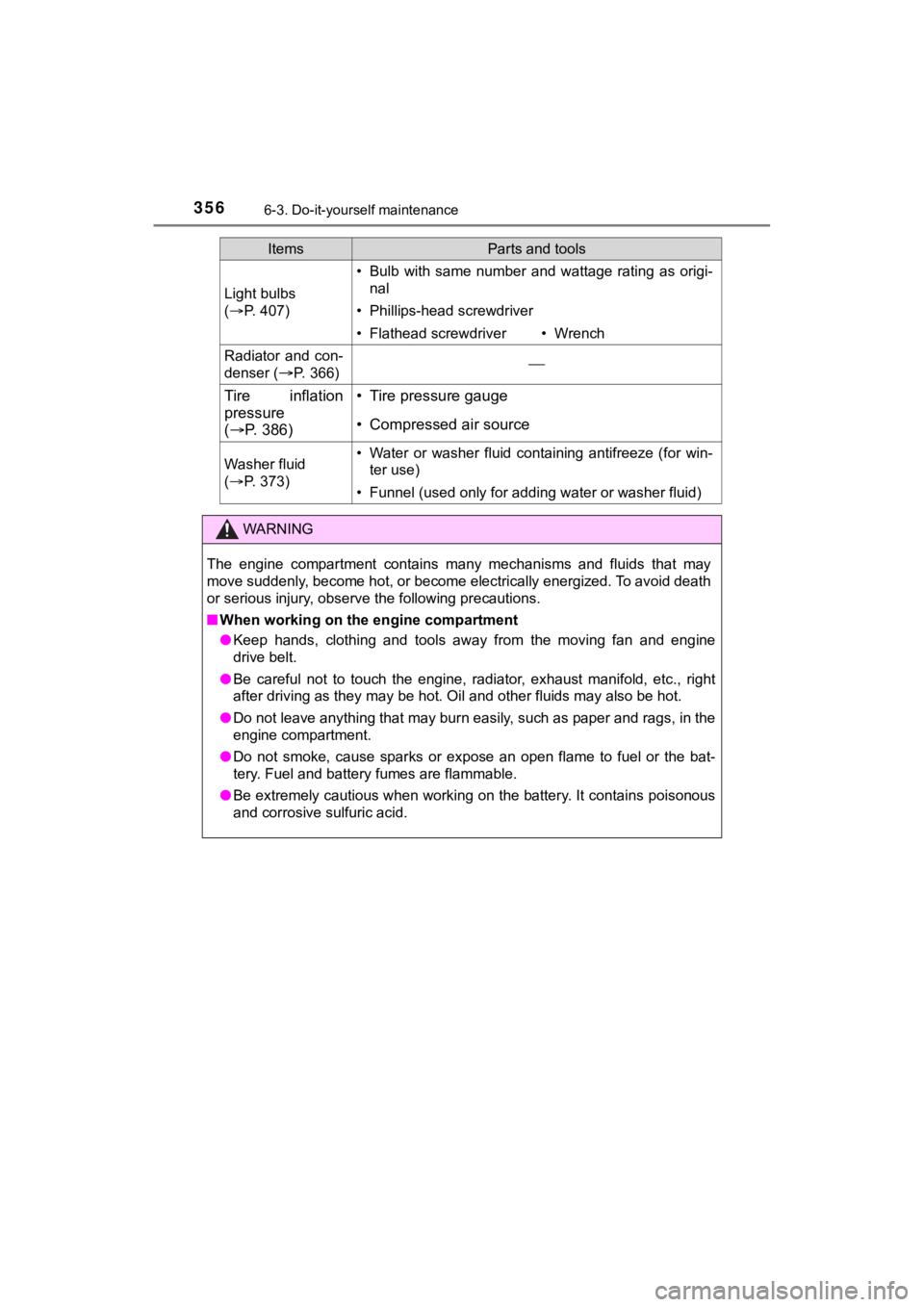2021 TOYOTA C-HR fuel pressure
[x] Cancel search: fuel pressurePage 15 of 548

15Pictorial index
C-HR_OM_USA_OM10684UWindshield wipers . . . . . . . . . . . . . . . . . . . . . . . . . . . . . . . . . P. 215
Precautions for winter . . . . . . . . . . . . . . . . . . . . . . . . . . . . . . . P. 306
To prevent freezing (windshield wiper de-icer)
*1. . . . . . . . . . . P. 315
Fuel filler door . . . . . . . . . . . . . . . . . . . . . . . . . . . . . . . . . . . . P. 220
Refueling method . . . . . . . . . . . . . . . . . . . . . . . . . . . . . . . . . . . P. 220
Fuel type/fuel tank capacity . . . . . . . . . . . . . . . . . . . . . . . . . . . P. 478
Tires . . . . . . . . . . . . . . . . . . . . . . . . . . . . . . . . . . . . . . . . . . . . P. 376
Tire size/inflation pressure . . . . . . . . . . . . . . . . . . . . . . . . . P. 482
Winter tires/tire chains . . . . . . . . . . . . . . . . . . . . . . . . . . . . P. 306
Checking/rotation/tire pressur e warning system . . . . . . . . .P. 376
Coping with flat tires . . . . . . . . . . . . . . . . . . . . . . . . . . . . . . P. 449
Hood . . . . . . . . . . . . . . . . . . . . . . . . . . . . . . . . . . . . . . . . . . . . P. 358
Opening . . . . . . . . . . . . . . . . . . . . . . . . . . . . . . . . . . . . . . . . . . P. 358
Engine oil . . . . . . . . . . . . . . . . . . . . . . . . . . . . . . . . . . . . . . . . . P. 478
Coping with overheating . . . . . . . . . . . . . . . . . . . . . . . . . . . . . P. 470
Camera
*2
Front side marker lights . . . . . . . . . . . . . . . . . . . . . . . . . . . . P. 204
Headlights . . . . . . . . . . . . . . . . . . . . . . . . . . . . . . . . . . . . . . . P. 204
Front fog lights
*1. . . . . . . . . . . . . . . . . . . . . . . . . . . . . . . . . . P. 214
Parking lights/daytime running lights . . . . . . . . . . . . . . . . . P. 204
Front turn signal . . . . . . . . . . . . . . . . . . . . . . . . . . . . . . . . . . P. 195
Parking lights/daytime running lights (LED type). . . . . . . . P. 204
Side turn signal lights . . . . . . . . . . . . . . . . . . . . . . . . . . . . . . P. 195
Tail lights/side marker lights/turn signal lights. . . . . . P. 195, 204
Back-up lights
Shifting the shift lever to R . . . . . . . . . . . . . . . . . . . . . . . . . . . . P. 190
License plate lights . . . . . . . . . . . . . . . . . . . . . . . . . . . . . . . . P. 204
Light bulbs of the exterior lights for driving
(Replacing method: P. 407, Watts: P. 483)
*1: If equipped
*2: Refer to “MULTIMEDIA OWNER’S MANUAL”.
Page 90 of 548

902. Instrument cluster
C-HR_OM_USA_OM10684U
*1: These lights turn on when the engine switch is turned to the “ON” position
(vehicles without a smart key system) or IGNITION ON mode (vehicles
with a smart key system) to indicate that a system check is being per-
formed. They will turn off after the engine is started, or after a few seconds.
There may be a malfunction in a system if a light does not come on, or if
the lights do not turn off. Have the vehicle inspected by your Toyota dealer.
*2: The light flashes to indicate a malfunction.
*3: The light comes on to indicate a malfunction.
*4: The light flashes or illuminates to indicate a malfunction.
*2Parking brake indicator (U.S.A.)P. 436
*2Parking brake indicator (Canada)P. 436
Low fuel level warning lightP. 437
Driver’s and front passenger’s seat belt
reminder light P. 437
Rear passengers’ seat belt reminder lights (on
the center panel)
P. 437
*1Tire pressure warning light
P. 437
Warning lightsPages
Page 103 of 548

1032. Instrument cluster
2
Instrument cluster
C-HR_OM_USA_OM10684U
●Vehicle Settings
Select the menu to set up the following items.
• RCTA setup ( P. 5 0 9 )
*
Select to change the RCTA buzzer volume.
• (Tire pressure warning system) setup ( P. 378)
Select to initialize the tire pressure warning system.
• RSA (Road Sign Assist) setup (P. 508)*
Select to set up RSA (Road Sign Assist).
● Meter settings
Select the menu to set up the following items.
• Language
Select to change the language on the display.
•Units
Select to change the unit of measure for fuel consumption.
• (Eco Driving Indicator Light) setup
Select to activate/deactivate the Eco Driving Indicator Light
• Drive information 1 and 2
Select to select up to 2 items that will be displayed on a Driv e informa-
tion screen, up to 2 Drive information screens can be set.
• Pop-up display
Select to enable/disable pop-up displays for incoming call disp lay of the
hands-free phone system.
• Initialisation
Registered or changed meter settings will be deleted or returne d to their
default setting.
*: if equipped
Page 356 of 548

3566-3. Do-it-yourself maintenance
C-HR_OM_USA_OM10684U
Light bulbs
( P. 4 0 7 )
• Bulb with same number and wattage rating as origi-
nal
• Phillips-head screwdriver
• Flathead screwdriver• Wrench
Radiator and con-
denser (
P. 366)
Tire inflation
pressure
( P. 386)• Tire pressure gauge
• Compressed air source
Washer fluid
( P. 3 7 3 )• Water or washer fluid containing antifreeze (for win-
ter use)
• Funnel (used only for adding water or washer fluid)
WARNING
The engine compartment contains many mechanisms and fluids that may
move suddenly, become hot, or become electrically energized. To avoid death
or serious injury, observe the following precautions.
■When working on the engine compartment
● Keep hands, clothing and tools away from the moving fan and eng ine
drive belt.
● Be careful not to touch the engine, radiator, exhaust manifold, etc., right
after driving as they may be hot. Oil and other fluids may also be hot.
● Do not leave anything that may burn easily, such as paper and r ags, in the
engine compartment.
● Do not smoke, cause sparks or expose an open flame to fuel or t he bat-
tery. Fuel and battery fumes are flammable.
● Be extremely cautious when working on the battery. It contains poisonous
and corrosive sulfuric acid.
ItemsParts and tools
Page 388 of 548

3886-3. Do-it-yourself maintenance
C-HR_OM_USA_OM10684U
■Tire inflation pressure check interval
You should check tire inflation pressure every two weeks, or at least once
a month.
Do not forget to check the spare.
■Effects of incorrect tire inflation pressure
Driving with incorrec t tire inflation pressure may result in th e following:
●Reduced fuel economy
●Reduced driving comfort and poor handling
●Reduced tire life due to wear
●Reduced safety
●Damage to the drivetrain
If a tire needs frequent inflating , have it checked by your Toyota dealer.
■Instructions for checking tire inflation pressure
When checking tire inflation p ressure, observe the following:
●Check only when the tires are cold.
If your vehicle has been parked for at least 3 hours or has not been
driven for more than 1 mile or 1.5 km, you will get an accurate cold tire
inflation pressure reading.
●Always use a tire pressure gauge.
It is difficult to judge if a tire is properly inflated based o nly on its appear-
ance.
●It is normal for the tire inflation pressure to be higher after driving as
heat is generated in the tire. Do not reduce tire inflation pre ssure after
driving.
●Never exceed the vehicle capacity weight.
Passengers and luggage weight should be placed so that the vehi cle is
balanced.
Page 437 of 548

4377-2. Steps to take in an emergency
7
When trouble arises
C-HR_OM_USA_OM10684U
Low fuel level warning lightIndicates that remaining fuel is approximately 2.0 gal.
(7.5 L, 1.6 Imp.gal.) or less
Refuel the vehicle.
*3
Driver’s and front passenger’ s seat belt reminder light
(warning buzzer) Warns the driver and/or front passenger to fasten their
seat belts.
Fasten the seat belt.
If the front passenger seat is occupied, the front pas-
senger’s seat belt also needs to be fastened to make
the warning light (warning buzzer) off.
*3
(On the center panel)
Rear passengers’ seat belt reminder lights (warning
buzzer)
Warn the rear passengers to fasten their seat belts
Fasten the seat belt.
Tire pressure warning light
When the light comes on:
Low tire inflation pressure such as
• Natural causes ( P. 4 4 0 )
• Flat tire ( P. 449)
Adjust the tire inflation pressure to the specified
level.
The light will turn off after a few minutes. In case
the light does not turn off even if the tire inflation
pressure is adjusted, have the system checked by
your Toyota dealer.
When the light comes on after blinking for 1 minute:
Malfunction in t he tire pressure warning system
( P. 4 4 0 )
Have the system checked by your Toyota dealer.
*1High engine coolant temperature warning light (warning
buzzer)
Indicates that the engine coolant temperature is too high
P. 470
Warning lightWarning light/Details/Actions
Page 442 of 548

4427-2. Steps to take in an emergency
C-HR_OM_USA_OM10684U
WARNING
■Maintenance of the tires
Each tire, including the spare (if provided), should be checked monthly
when cold and inflated to the inflation pressure recommended by the
vehicle manufacturer on the vehicle placard or tire inflation p ressure
label (tire and load information label). (If your vehicle has t ires of a dif-
ferent size than the size indica ted on the vehicle placard or tire inflation
pressure label [tire and load information label], you should de termine
the proper tire inflation p ressure for those tires.)
As an added safety feature, your vehicle has been equipped with a tire
pressure monitoring system (TPMS -tire pressure warning system) that
illuminates a low tire pressure telltale (tire pressure warning light) when
one or more of your tires is significantly under-inflated. Acco rdingly,
when the low tire pressure telltale (tire pressure warning ligh t) illumi-
nates, you should stop and check your tires as soon as possible , and
inflate them to the proper pressure. Driving on a significantly under-
inflated tire causes the tire to overheat and can lead to tire failure.
Under-inflation also reduces fuel efficiency and tire tread lif e, and may
affect the vehicle’s handl ing and stopping ability.
Please note that the TPMS (tire pressure warning system) is not a sub-
stitute for proper tire maintena nce, and it is the driver’s responsibility to
maintain correct tire pressure, even if under-inflation has not reached
the level to trigger illumination of the TPMS low tire pressure telltale (tire
pressure warning light).
Your vehicle has also been equipped with a TPMS (tire pressure warn-
ing system) malfunction indicato r to indicate when the system is not
operating properly. The TPMS (tire pressure warning system) mal func-
tion indicator is combined with the low tire pressure telltale (tire pressure
warning light). When the system detects a malfunction, the tell tale will
flash for approximately one mi nute and then remain continuously illumi-
nated. This sequence will continue upon subsequent vehicle star t-ups
as long as the malfunction exists . When the malfunction indicator is illu-
minated, the system may not be able to detect or signal low tir e pres-
sure as intended.
TPMS (tire pressure warning system) malfunctions may occur for a vari-
ety of reasons, including the installation of replacement or al ternate tires
or wheels on the vehicle that prevent the TPMS (tire pressure w arning
system) from functioning properly. Always check the TPMS (tire pres-
sure warning system) malfunction telltale after replacing one or more
tires or wheels on your vehicle to ensure that the replacement or alter-
nate tires and wheels allow the TPMS (tire pressure warning sys tem) to
continue to function properly.
Page 494 of 548

4948-1. Specifications
C-HR_OM_USA_OM10684U
Glossary of tire terminology
Tire related termMeaning
Cold tire inflation pres-
sure
Tire pressure when the vehicle has been
parked for three hours or more, or has not
been driven more than 1 mile or 1.5 km under
that condition
Maximum inflation
pressureThe maximum cold inflated pressure to which
a tire may be inflated, shown on the sidewall
of the tire
Recommended infla-
tion pressureCold tire inflation pressure recommended by a
manufacturer
Accessory weight
The combined weight (in excess of those stan-
dard items which may be replaced) of auto-
matic transmission, power steering, power
brakes, power windows, power seats, radio
and heater, to the extent that these items are
available as factory-installed equipment
(whether installed or not)
Curb weight
The weight of a motor vehicle with standard
equipment, including the maximum capacity of
fuel, oil and coolant, and if so equipped, air
conditioning and additional weight optional
engine
Maximum loaded vehi-
cle weight
The sum of:
(a) Curb weight
(b) Accessory weight
(c) Vehicle capacity weight
(d) Production options weight
Normal occupant
weight150 lb. (68 kg) times the number of occupants
specified in the second column of Table 1
*
that follows
Occupant distributionDistribution of occupants in a vehicle as speci-
fied in the third column of Table 1
* below